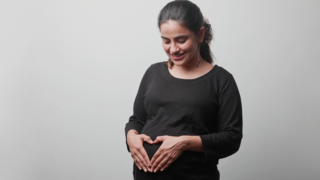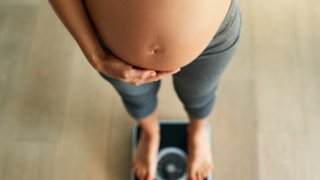
Week 36 of Pregnancy

Key Takeaways at Week 36
- Four weeks remain, at least until your due date. There's no guarantee the baby will arrive on time
- At this point in your pregnancy, the baby weighs just around 6 pounds, give or take
- From now on, you will see your obstetrician on a weekly basis. If you haven't already received your Step B test, it will be administered this week. It's only a light swab of the vagina and rectum. If you test positive, don't worry as antibiotics will be administered during birth to safeguard the baby
- Because the baby could arrive any day now, attempt to complete your final preparations. Examine your transportation strategy and all potential outcomes. Keep your boss and colleagues up to date on the progress of all your work projects so they know where to take over if you are unexpectedly absent from the office. Week 36 of pregnancy is also an excellent time for a date with your partner
- If you are in Week 36 of your pregnancy you are in the third trimester and in the ninth month
- 4 more weeks remaining in your pregnancy
Baby's Movement and Baby’s Development at Week 36
At 36 weeks pregnant, the baby's liver and kidneys are functioning properly. And the circulatory and immunological systems are primed for action. Now, the baby is coming closer to being able to breathe on their own. Furthermore, your foetus's skin is becoming smoother and softer. They are also preparing to enter the world outside the womb. They continue to lose lanugo, the little hairs that coat their bodies to protect their skin and keep them warm in the uterus.36 weeks is also a significant milestone since the baby will be able to suck to feed and their stomach is prepared to digest breast milk. This sucking reflex is critical since they will be feeding off breast milk or formula (or a combination of both) for the next six months or more.
Is the baby completely developed at 36 weeks?
Baby is almost finished growing inside you and will be ready to enter the world shortly. However, the baby still has to grow a little further during week 36. This includes gaining weight and allowing the brain, lungs, liver, and other organs to mature. That is why it is best for the baby to stay in your belly for a few more weeks.- Baby Weight: Over 2.6 Kg
- Baby Length: 20-21 inches long
- Baby Size: Comparable to a papaya.
Is it Safe to Deliver at 36 Weeks?
Ideally, the baby would wait a few more weeks. A baby born at 36 weeks has a high probability of being entirely healthy; yet, because it is still late preterm, there is a possibility of some health concerns, such as low birth weight or respiratory distress syndrome. Don't worry, your OB will take excellent care of you and your baby during the delivery, whenever it occurs.36 Weeks Pregnant: Baby Movement
At 36 weeks, your baby's amniotic sac is growing quite crowded. With limited space, your growing peanut may not be flipping and drifting around as much as they once did, but they will continue to kick, wiggle, jab, and poke. Doctors may advise you to count your baby's kicks to monitor their mobility and to call your doctor if something out of the ordinary occurs.Pregnancy Symptoms and Body Changes This Week
During week 36 of pregnancy, your body is quickly changing. As your baby grows, so will you, and you may feel specific pregnancy symptoms throughout this period.- You may be breathing easier. The baby has sunk low into your pelvis, relieving strain on the lungs and stomach. More strain on your bladder, resulting in an urge to urinate more frequently
- You may feel sharp, shooting pains in your pelvis, vagina, or rectum. This discomfort, called lightning crotch (symphysis pubis dysfunction), might be caused by the baby's movement, the strain on pelvic nerves, or the stretching of the ligaments that support your belly. Staying active, wearing a belly support belt, and changing postures may help
- There can be a rise in the frequency of Braxton Hicks contractions. These false alarms are nature's way of preparing you for the real thing
- Are your rings or shoes tight? It's most likely related to oedema caused by water retention. Swelling of the hands, legs, feet, and ankles is common during pregnancy. But don't give up; you just have a few weeks left, and it will go down when you give birth. If you have extreme oedema, swelling in your face, or rapid weight gain, consult your doctor because this could be an indication of preeclampsia
- At this time in your pregnancy, insomnia is almost unavoidable, whether owing to aches and pains, belly size, a congested nose, or feeling hot. Try these sleep tactics like keeping your room dark and cool to obtain the rest you and your baby require
- While you are tossing and turning at night, you may suddenly feel compelled to clean, straighten up the baby's room, and reorganise and redesign your entire home. The nesting instinct may appear to be an old wives' tale, but it is a common phenomenon. Just remember to take extra precautions and avoid carrying heavy objects, standing on ladders, and using dangerous chemicals
Body Changes This week
During the next few weeks, you may remove the mucus plug that has been protecting your baby from the outside world. If you do, you will see a clear or yellow discharge. It does not necessarily indicate that labour will begin shortly. The big day could be several weeks away. Call your doctor right away if the discharge soaks a pad in less than an hour or is bright red; otherwise, share the update with your doctor at your next examination.You may also observe bloody mucus. The discharge has gained the term "bloody show." While the mucus plug and bloody show are similar, the bloody show indicates that labour is approaching, possibly within the next day or two.
36-week Ultrasound
At your week 36-week prenatal appointment, your doctor may examine the baby's position. At this moment, the baby should be head-down. If not, they are considered "breeches." If your baby is breech at 36 weeks, don't panic. There's a chance the baby will turn naturally.Alternatively, your OB may recommend a version procedure for a breech baby. A version is an attempt to turn the baby by pushing and/or raising the pregnant belly. It sounds rough, but don't worry. It's a low-risk surgery that works more than 50% of the time. Before the procedure, you may be given medicine to calm your uterus. You will get an ultrasound so that the doctor can clearly identify the baby's position and the placement of the placenta. Throughout the procedure, ultrasound will be used to guide the doctor's actions. In addition, the baby's heart rate will be monitored before, after, and possibly even during the version to ensure that everything is in order. Hopefully, things will improve shortly.
You will also be given a Group B Strep test around week 36 of your pregnancy. This is a test to see if you have the common bacterium Group B Strep in your body. If you do, you might not even realise it, or it could lead to a condition like a UTI. However, for the newborn, the bacterium could cause more serious issues, including death. Approximately one in every four pregnant women carries Group B strep. The treatment is straightforward: you'll need an antibiotic infusion during labour to dramatically limit the risk of spreading the infection to the baby.
If you're pregnant with twins or have a high-risk condition like high blood pressure, renal or heart disease, you might have a biophysical profile this week. This combination of ultrasound and non-stress tests gives your doctor a good image of how the baby is doing and eliminates the need to deliver prematurely.
Your Baby Bump at Week 36
At this stage, your tummy is unlikely to vary significantly from week to week. You've probably gained 11 to 15 kg total, which is an acceptable amount of pregnancy weight gain for women with a normal BMI. That's probably making it difficult to move (or waddle) around. You won't gain too much weight from here on out.If you're pregnant with twins, you've probably gained 15 to 20 kg altogether. To say your stomach is full is an understatement. While many twin parents give birth around week 36, you and your partner may be able to wait a few weeks longer. Remember that the longer you go, the less likely your babies will require NICU care following birth. So, even if you're feeling quite uncomfortable, realise that this extra time in utero is extremely beneficial to the twins.
Signs of Labour at 36 weeks
There are a few clear signals that your baby is eager to meet you! Your water breaking is the first symptom that you might be ready to give birth. Whether it's a trickle or a gush, it's time to move. Regular contractions (not the Braxton Hicks sort) are another sign that labour is beginning. Finally, there is back labour, which is ongoing and can be considerably more painful than typical pregnancy symptoms.At this stage, the signals of labour might be difficult to distinguish from normal pregnancy discomforts, so call your doctor if anything appears out of the ordinary. It's worth calling, and, yes, going to the hospital to find out whether it's fake labour. The worst that may happen is that you're sent home to rest and wait.
Tips at Week 36
- The final few weeks of pregnancy might feel painfully long. However, there is a light at the end of the tunnel, and you will meet your baby before you realise it. In the meantime, try to stay active by taking short walks
- If you have lately experienced heartburn, you may want to avoid indulging. Bland food can be monotonous, but you'll be grateful to avoid that discomfort later. Also, avoid foods high in citrus or vinegar, as well as those that are fried. (Regardless of how amazing they taste at the moment!)
- Don't eat dinner too late as a large meal close to bedtime can keep you awake, costing you valuable hours of sleep. Stop eating at least two hours before bedtime. That means no munching either
- Swollen feet and ankles benefit greatly from rest, and rest is always welcome during pregnancy! To reduce swelling, prop your feet up on a cushion when resting down
- If your baby is weighing on your pelvic area, consider investing in a sling or band that provides support and relieves some of the pressure. Wear it only briefly (and not too tightly) to avoid restricting blood flow
Checklist for Week 36
- Schedule your 37-week prenatal appointment (visits will now be weekly)!
- Finalise your maternity leave strategy
- Create a labour playlist
- Practice utilising your baby gear (for example, learn how to fold and unfold your strollers)
Frequently Asked Questions on Week 36 of Pregnancy
- Can I decline cervix checks at this point?
You have the freedom to decline cervix checks at any moment throughout your pregnancy or period. That being said, you should have open communication with your provider about why they are recommending the check. If you are experiencing signs of labour, your doctor may want to examine your cervix to see how far along you are (or how long you have until it's time to push). If you have no indicators of labour, a cervix check may not be necessary, and you may decline the test. - When should I visit the hospital if I suspect early labour?
If you suspect labour at 36 weeks, contact your provider or go to your labour and delivery department for an assessment. Contractions that occur six or more times per hour, cramping in your lower abdomen, an increase or change in vaginal discharge, pelvic pressure that feels like the baby is pushing down, low dull backache below the waistline, or abdominal cramping with or without diarrhoea are all warning signs of premature labour. Remember that the baby is not considered full term until 37 weeks gestation, therefore treat any premature labour signals seriously and see a doctor as soon as possible.








